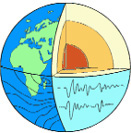Observation and modelisation of the Earth’s deformations
The “Geodynamics and Structures” team is interested in the Earth’s deformations from the global scale to the crustal scale, as well as their interactions with other processes (erosion, volcanism, hydrothermalism, alteration). In this context, research within the team focuses on how the lithosphere responds to forcings of various time scales: large earthquakes, seasonal loads, ice melting, sedimentation/erosion cycles, climate change, kinematic changes, etc. Current and finished deformations are observed and quantified using onshore geodesic measurements, geophysical measurements at sea, and geological studies on land as well as at sea. Measured deformations are the result of many interlocking processes that need to be separated and modeled to understand their interactions.
Space geodesy (GNSS, INSAR) for example measures the Earth’s recent deformations with an accuracy of about one millimetre per year over distances of several thousand of kilometres. This precision allows to record all at once intraplate deformations in the parts deemed “stable” of large continental plates, effects related to the seismic cycle (including from far-field for large earthquakes), or deformations related to seasonal or longer-term hydrological loads (ice melting). The development of seafloor geodesy and direct observation (submersibles and robots) of displacements along underwater faults complement these measures of short-term deformations.
Onshore and offshore geological studies by seismic imaging, as well as mapping, provide access to structures resulting from cumulative deformations at long or short term. They allow characterization of large fault systems and access to the spatio-temporal evolution of activity on these faults, in particular through the sedimentary record of the deformation. Structural geology on land and at sea, as well as mineral transformations associated with rock burial and/or exhumation, tell us about the complex links between chains and basins during geological times.
All these observations are placed in their geodynamic framework and feed a set of modeling at multiple scales: models of elastic coupling around large active faults, models of post-seismic mantle relaxation after large earthquakes, thermomechanical models of the faults evolution according to rheology and surface processes, down to global models of deep convection and its coupling with the large movements of lithospheric plates.
People
12 Permanents
Frédérick Boudin – Eric Calais – Nicolas Chamot-Rooke – Christian Chopin
Nicolas Coltice – Matthias Delescluse – Javier Escartin – Luce Fleitout
Émilie Klein – Jean-Arthur Olive – Manuel Pubellier – Christophe Vigny
2 Post-doc researchers
Rémi Coltat – Cédric Bulois
6 PhD students
Marie Baïsset – Hugo Boulze – Simon Bufféral – Mario Ruben Fernandez – Alexandre Janin – Léo Petit
